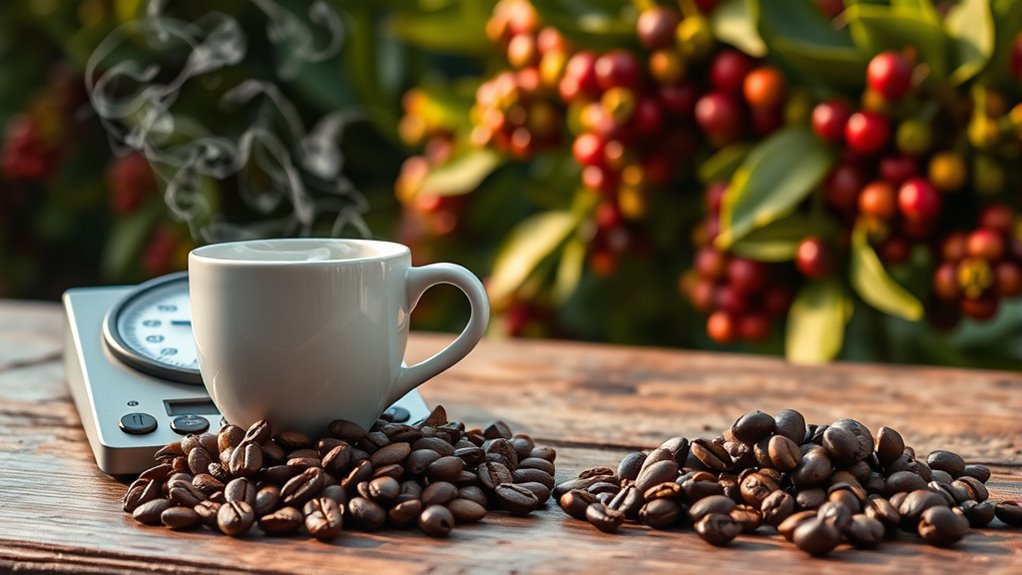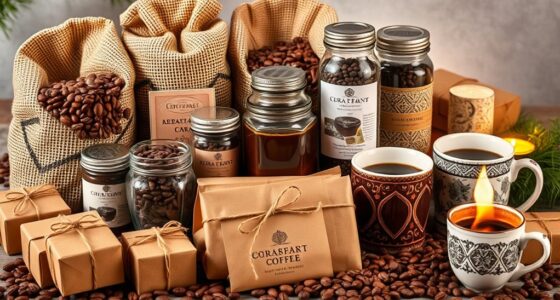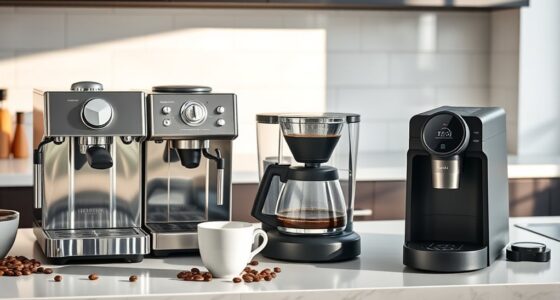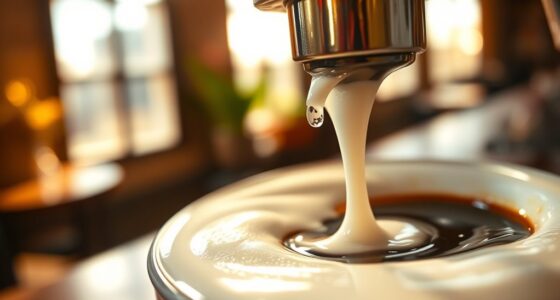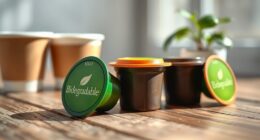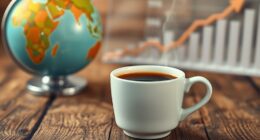To find the true cost per cup, you need to look beyond the price per pound. Consider factors like brewing method, energy use, and equipment depreciation, which all influence expenses. Quality and sustainability also matter, as higher-quality beans and fair sourcing can add value. Reducing waste through efficient brewing practices saves money too. If you want to discover how to calculate these hidden costs and get better value, keep exploring the details ahead.
Key Takeaways
- Consider the total coffee weight used per cup, including waste and grind size, not just the price per pound.
- Factor in energy costs for brewing, such as water temperature and equipment efficiency, to assess true expenses.
- Account for storage and freshness preservation to reduce spoilage and waste, impacting overall cost.
- Evaluate quality and flavor profiles, as higher-quality beans may justify higher costs for better value.
- Include operational costs like equipment depreciation, maintenance, and labor to determine the real cost per cup.
Understanding the Components of Coffee Cost
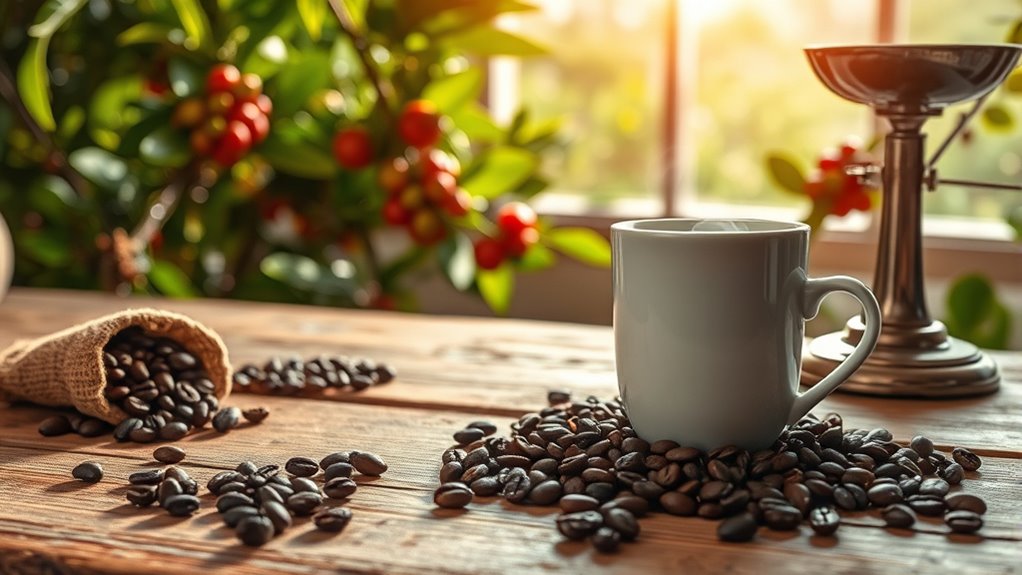
To understand the true cost of a cup of coffee, you need to break down its main components. First, consider coffee storage; proper storage prevents spoilage and preserves freshness, which affects quality and ultimately, your costs. If coffee isn’t stored correctly, you risk wasting beans or losing flavor, leading to higher expenses over time. Next, think about brewing temperature. Achieving the right temperature ensures ideal extraction, enhancing flavor and reducing waste. Brewing at too high or too low temperatures can produce weak or bitter coffee, forcing you to redo or discard brews. Additionally, special occasions such as celebrations or gatherings can influence your coffee consumption and cost considerations, especially when serving larger groups. These factors might seem small, but they profoundly influence your overall coffee costs. Paying attention to storage and brewing temperature helps you maximize quality and efficiency, saving money in the long run.
Calculating Cost per Brew Method
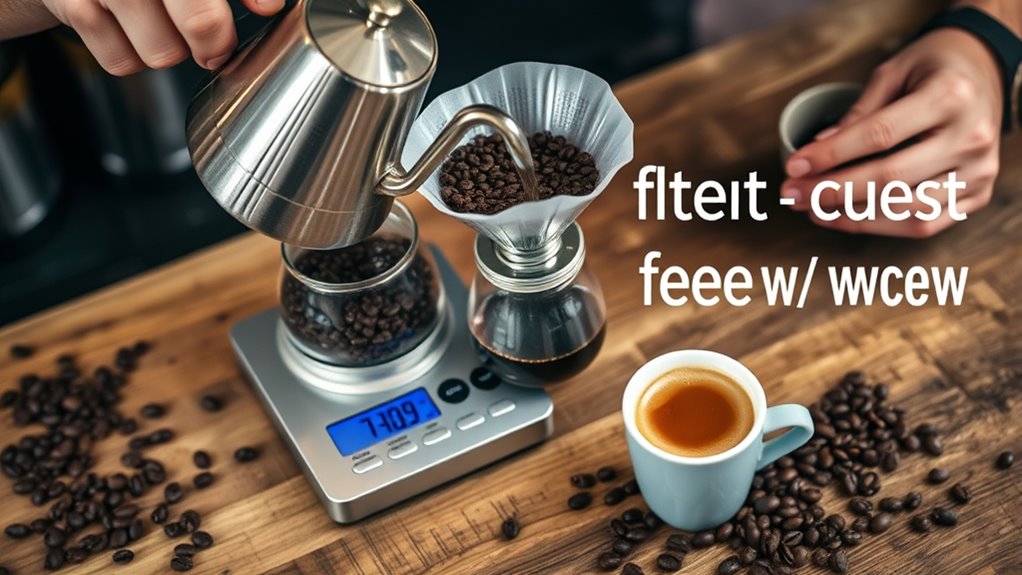
Calculating the cost per brew method involves analyzing the specific expenses associated with each technique you use to prepare coffee. Your choice of brew impacts costs through factors like grind size adjustments and water temperature control, which influence extraction efficiency. To determine your cost:
- Calculate the amount of coffee used, considering grind size and how it affects extraction and waste.
- Factor in energy costs for heating water to the ideal temperature for each method.
- Include equipment depreciation or replacement costs specific to each technique.
- Take into account tuning modifications that can optimize equipment performance and energy efficiency for different brewing methods.
Assessing Quality and Its Impact on Value
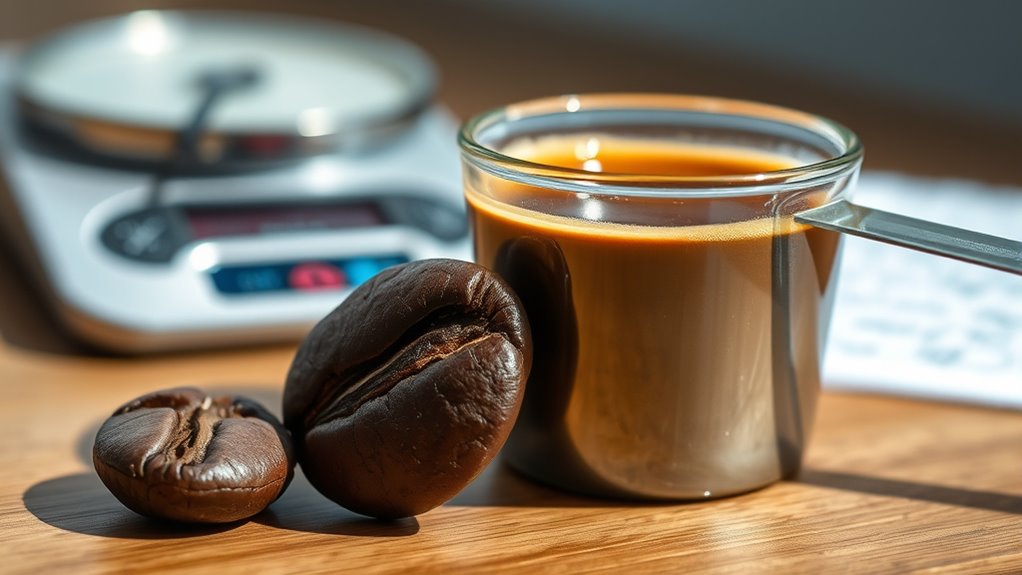
How do you determine if a cup of coffee is worth its cost? You assess its quality by paying attention to flavor profiles and roast levels. Flavor profiles reveal the complexity of tasting notes, from fruity and floral to nutty or spicy, helping you gauge how well the coffee matches your preferences. Roast levels also influence quality, with light roasts highlighting origin characteristics and dark roasts offering boldness. A higher-quality coffee often exhibits a balanced, vibrant flavor profile, reflecting careful sourcing and roasting. When you evaluate these factors, you see beyond the price tag and understand the true value. A well-crafted cup, rich in nuanced flavors and appropriate roast levels, can justify a higher cost because it delivers a more satisfying experience. Additionally, ethical sourcing practices contribute to the overall value, ensuring that your purchase supports sustainable and fair-trade initiatives.
Considering Sustainability and Ethical Sourcing
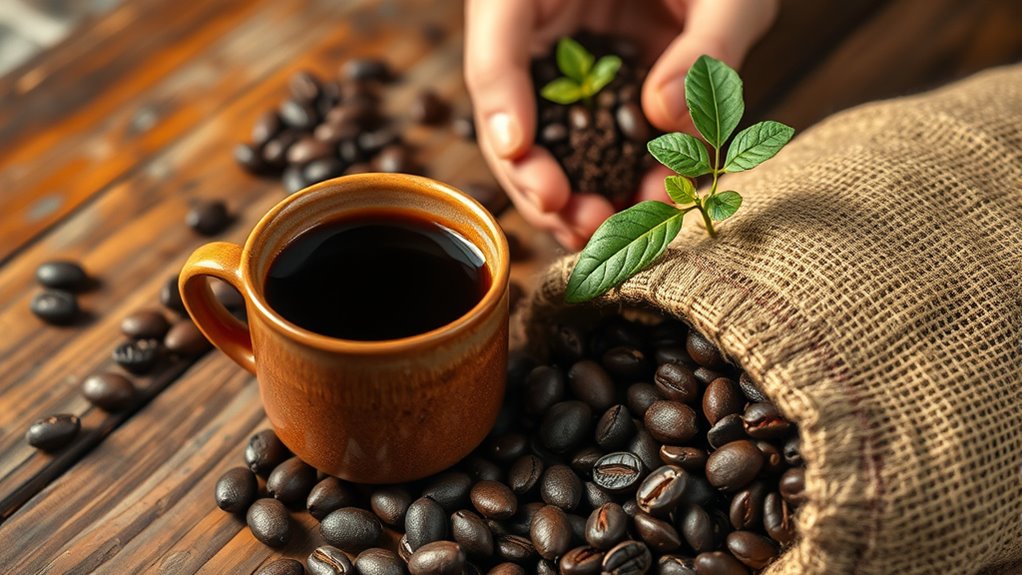
Considering sustainability and ethical sourcing is essential when evaluating the true value of your coffee. By choosing brands that prioritize Fair Trade practices, you support fair wages and better working conditions for farmers. Additionally, understanding a coffee’s Carbon Footprint helps you gauge its environmental impact. Here are three key points to take into account:
- Fair Trade Certification: Ensures ethical labor practices and social responsibility.
- Environmental Impact: Look for brands committed to reducing Carbon Footprint through sustainable farming.
- Transparency: Choose companies that openly share their sourcing and sustainability efforts.
- Incorporating knowledge about raw food preparation and sourcing can also inform more sustainable choices in your coffee consumption.
Evaluating Brewing Efficiency and Waste
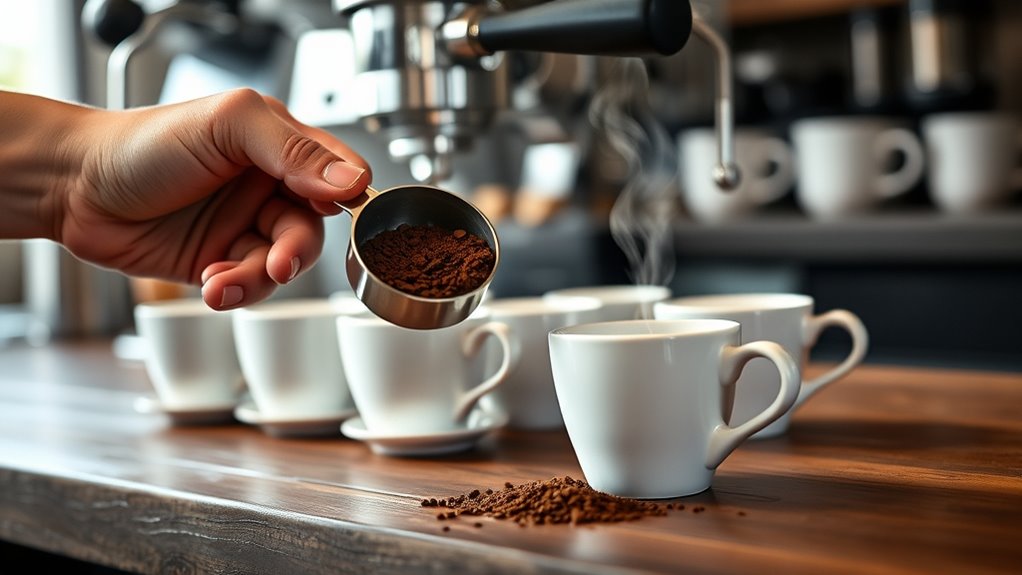
Have you ever thought about how much waste your brewing process generates or how efficiently you’re using your coffee? One key factor is grind consistency. Inconsistent grinds can lead to over- or under-extraction, increasing waste and lowering efficiency. Ensuring a uniform grind helps you extract maximum flavor while minimizing leftover grounds. Additionally, brew temperature plays a vital role. If your water’s too hot or too cold, you might end up with weak or bitter coffee, leading to discarded brews. Monitoring and maintaining ideal brew temperature reduces waste and improves overall efficiency. Recognizing the importance of self-awareness in your brewing habits can help you identify areas for improvement. By paying attention to grind consistency and brew temperature, you can cut back on waste, get more value from your beans, and make your brewing process more cost-effective.
Making Informed Choices for Better Value
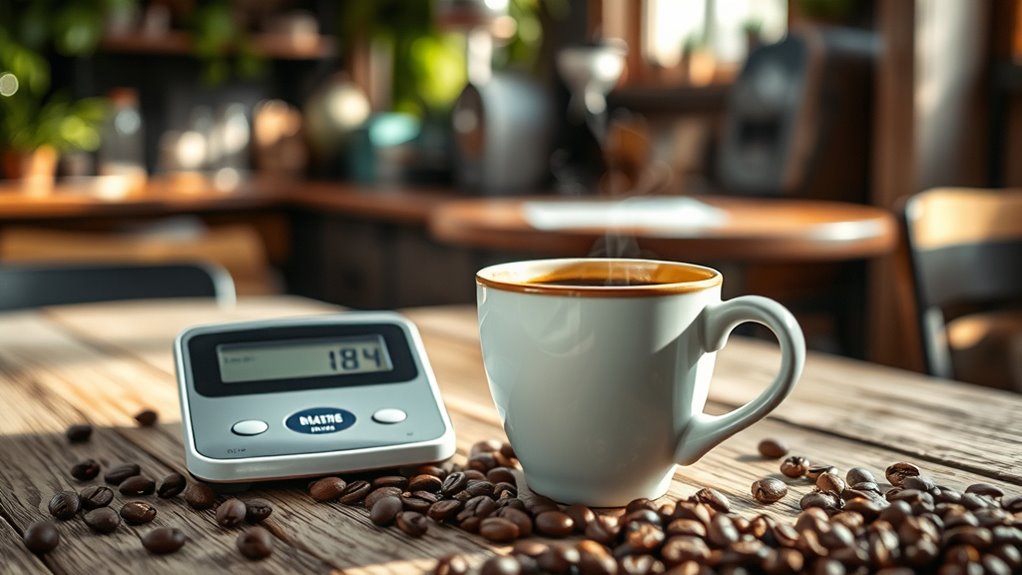
Making informed choices about your coffee supplies and brewing methods can considerably boost your overall value. To do this effectively, consider these strategies:
Smart coffee choices enhance flavor and save money through better supplies and brewing methods.
- Evaluate pricing strategies by comparing cost per pound and quality, ensuring you get the best value for your money.
- Recognize how marketing tactics influence your perception of quality and price, helping you avoid unnecessary premium costs.
- Select brewing methods that maximize efficiency, reduce waste, and improve flavor, lowering your overall cost per cup.
Frequently Asked Questions
How Does Storage Affect the Overall Cost of Coffee?
Storage impacts your overall coffee costs substantially. Poor storage conditions can cause beans to spoil or lose flavor, leading to waste and additional expenses. Using the right packaging materials helps protect coffee from moisture, oxygen, and pests, preserving quality longer. By maintaining ideal storage conditions, you minimize spoilage and waste, ultimately reducing your total costs and ensuring each cup retains its flavor and value.
What Role Does Grind Size Play in Cost Efficiency?
Ever wonder how grind size impacts your coffee budget? It’s not just about taste; grind consistency and precise grind size directly influence extraction and efficiency. Small adjustments can prevent wastage, optimize flavor, and save money over time. When you master the right grind size for your brewing method, you reveal better value, making each cup more cost-effective. So, paying attention to grind size isn’t just about quality — it’s a smart move for your wallet too.
How Do Different Brewing Equipment Impact Long-Term Expenses?
Different brewing equipment markedly impacts your long-term expenses through equipment maintenance and energy consumption. For example, high-end machines might cost more upfront but save money over time with efficient operation and durability. Cheaper equipment could require frequent repairs, increasing maintenance costs. Additionally, energy-efficient models reduce electricity bills. Choosing the right equipment balances initial investment with ongoing expenses, helping you maximize value and keep costs manageable in the long run.
Can Seasonal Variations Influence Coffee Pricing and Value?
You might think seasonal variations don’t matter, but seasonal pricing and harvest fluctuations considerably impact coffee value. During harvest times, prices drop, making quality beans more affordable, while off-season, costs rise due to scarcity. This fluctuation affects your long-term investment, influencing flavor and consistency. By understanding these cycles, you can plan purchases wisely, ensuring better quality and value, even when prices temporarily spike or dip.
How Do Personal Preferences Affect Perceived Coffee Cost and Quality?
Your personal preferences greatly influence how you perceive coffee cost and quality. If you love bold flavors, you might value specialty beans more, considering their aroma perception and flavor profiles worth the extra price. Conversely, if you prefer milder tastes, you might see less value in pricier options. Your unique taste preferences shape what you deem worth paying for, making your experience subjective and personalized rather than solely based on price.
Conclusion
Now that you see the true cost per cup, remember it’s more than just a number—it’s a journey through quality, sustainability, and efficiency. Like piecing together a mosaic, each element adds color and depth to your coffee experience. By considering all these factors, you can make smarter choices that bring richer flavor and better value to your mornings. So, next time you brew, think beyond the price tag and savor the story behind each sip.
